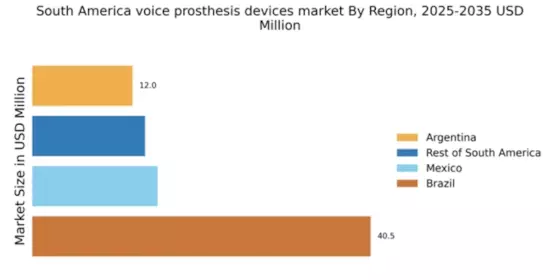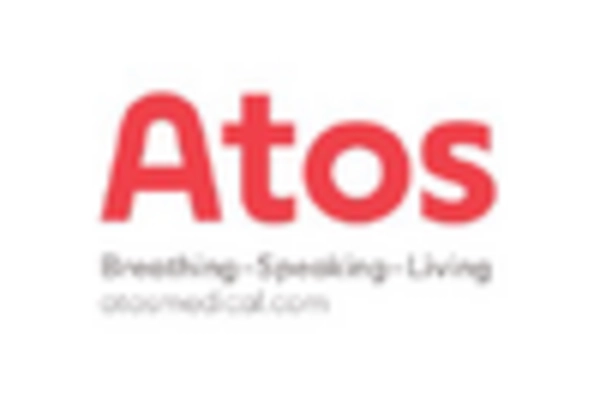Government Initiatives and Funding
Government initiatives aimed at improving healthcare access and funding for medical devices are significant drivers for the voice prosthesis-devices market. In South America, various governments have launched programs to subsidize the cost of medical devices, including voice prostheses, making them more accessible to patients. For example, funding allocations for cancer treatment and rehabilitation services have increased, with some countries earmarking up to $50 million annually for such initiatives. This financial support is likely to enhance the availability of voice prosthesis devices, thereby fostering growth in the market. The voice prosthesis-devices market stands to benefit from these initiatives, as they not only improve patient access but also encourage manufacturers to innovate and expand their product offerings.
Rising Incidence of Laryngeal Cancer
The increasing incidence of laryngeal cancer in South America is a critical driver for the voice prosthesis-devices market. According to health statistics, laryngeal cancer cases have shown a notable rise, with estimates suggesting that the number of new cases could reach approximately 10,000 annually by 2025. This alarming trend necessitates the development and adoption of voice prosthesis devices, as they provide essential support for patients who undergo laryngectomy. The voice prosthesis-devices market is likely to experience growth as healthcare providers seek effective solutions to improve the quality of life for these patients. Furthermore, the rising awareness of treatment options among patients and healthcare professionals may further stimulate demand for these devices, indicating a potential upward trajectory for the market in the coming years.
Aging Population and Associated Health Issues
The aging population in South America presents a substantial driver for the voice prosthesis-devices market. As the demographic shifts towards an older population, the prevalence of age-related health issues, including laryngeal disorders, is expected to rise. Reports indicate that by 2030, approximately 20% of the population will be over 65 years old, leading to an increased demand for medical interventions, including voice prosthesis devices. The voice prosthesis-devices market is likely to see a surge in demand as older adults seek solutions to maintain their quality of life. This demographic trend suggests that manufacturers should focus on developing products tailored to the needs of elderly patients, potentially enhancing market growth in the coming years.
Technological Innovations in Prosthetic Devices
Technological innovations play a pivotal role in shaping the voice prosthesis-devices market. Recent advancements in materials and design have led to the development of more efficient and user-friendly devices. For instance, the introduction of silicone-based prostheses has improved comfort and durability, which is crucial for patient acceptance. The voice prosthesis-devices market is witnessing a shift towards devices that offer enhanced functionality, such as adjustable airflow and improved sound quality. As manufacturers invest in research and development, the market is expected to expand, with projections indicating a growth rate of around 8% annually over the next five years. This trend suggests that technological progress will continue to drive the adoption of voice prosthesis devices across South America.
Increased Collaboration Between Healthcare Providers and Manufacturers
Increased collaboration between healthcare providers and manufacturers is emerging as a vital driver for the voice prosthesis-devices market. Partnerships aimed at improving patient outcomes and device efficacy are becoming more common in South America. Such collaborations often involve clinical trials and feedback mechanisms that inform product development, ensuring that devices meet the specific needs of patients. This synergy is likely to enhance the quality and effectiveness of voice prosthesis devices, thereby boosting their adoption in clinical settings. The voice prosthesis-devices market may experience accelerated growth as these partnerships foster innovation and lead to the introduction of advanced products that cater to the evolving demands of healthcare professionals and patients alike.


















Leave a Comment